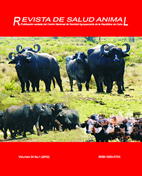TIPIFICATION BY CAPSULAR REACTION TEST of Streptococcus suis ISOLATED IN PIGS GENOTYPES cps 2J+ AND cps 9J+
Contenido principal del artículo
Resumen
Dear Editor:
Streptococcus suis is a high pathological gram-positive bacterium infecting pigs. In this species, 33 capsular serotypes are recognized; however the most prevalent are serotypes 1/2, 2, 3, 7, 9 and 14, but the distribution of predominant serotypes may vary in different geographic regions. Serotype 2 is the most pathogenic and shows an elevated zoonotic potential.
Our lab has worked on the obtaining of specific antiserum to capsular genotype cps 2J+ and cps 9J+ of Streptococcus suis from clinical isolates associated to pathological lesions of swine respiratory tract.
A rapid diagnostic based agglutination test which allows an easy, rapid, cost-effective and specific discrimination among different streptococcus and others related with porcine respiratory complex bacterial strains have been assayed.
Both antisera (vs-cps 2 and vs-cps 9) recognized the homologue strain with titer of 1/32 and did not show a positive reaction with other bacteria associated to pig respiratory complex, sush as Mycoplasm hyopneumoneae, Pasteurella multocida, other genotypes of Streptococcus suis used in this study, as well as Streptococcus equisimilis (zooepideremicus) and Mycoplasm hyorini.
For further studies, it necessary to increase the number of isolates. More specific and sensitive techniques for diagnosis of genotype cps 2J+ and cps 9 will be assayed directly in clinical samples as organs with invasive procedures, nasal and bronchial swabs
Streptococcus suis is a high pathological gram-positive bacterium infecting pigs. In this species, 33 capsular serotypes are recognized; however the most prevalent are serotypes 1/2, 2, 3, 7, 9 and 14, but the distribution of predominant serotypes may vary in different geographic regions. Serotype 2 is the most pathogenic and shows an elevated zoonotic potential.
Our lab has worked on the obtaining of specific antiserum to capsular genotype cps 2J+ and cps 9J+ of Streptococcus suis from clinical isolates associated to pathological lesions of swine respiratory tract.
A rapid diagnostic based agglutination test which allows an easy, rapid, cost-effective and specific discrimination among different streptococcus and others related with porcine respiratory complex bacterial strains have been assayed.
Both antisera (vs-cps 2 and vs-cps 9) recognized the homologue strain with titer of 1/32 and did not show a positive reaction with other bacteria associated to pig respiratory complex, sush as Mycoplasm hyopneumoneae, Pasteurella multocida, other genotypes of Streptococcus suis used in this study, as well as Streptococcus equisimilis (zooepideremicus) and Mycoplasm hyorini.
For further studies, it necessary to increase the number of isolates. More specific and sensitive techniques for diagnosis of genotype cps 2J+ and cps 9 will be assayed directly in clinical samples as organs with invasive procedures, nasal and bronchial swabs
Detalles del artículo
Cómo citar
1.
Baez M, Espinosa I, Martínez S, Vichi J. TIPIFICATION BY CAPSULAR REACTION TEST of Streptococcus suis ISOLATED IN PIGS GENOTYPES cps 2J+ AND cps 9J+. Rev. Salud Anim. [Internet]. 22 de mayo de 2013 [citado 18 de noviembre de 2025];34(1):63. Disponible en: https://revistas.censa.edu.cu/index.php/RSA/article/view/75
Número
Sección
CARTAS AL EDITOR
Aquellos autores/as que tengan publicaciones con esta revista, aceptan los términos siguientes:
- Los autores/as conservarán sus derechos de autor y garantizarán a la revista el derecho de primera publicación de su obra, el cual estará simultáneamente sujeto a la Licencia Creative Commons Attribution-NonCommercial 4.0 International (CC BY-NC 4.0) que prohíbe el uso comercial de sus publicaciones y permite a terceros compartir la obra siempre que se indique su autor y la primera publicación en esta revista. Bajo esta licencia el autor será libre de:
- Compartir — copiar y redistribuir el material en cualquier medio o formato
- Adaptar — remezclar, transformar y crear a partir del material
- El licenciador no puede revocar estas libertades mientras cumpla con los términos de la licencia
Bajo las siguientes condiciones:
- Reconocimiento — Debe reconocer adecuadamente la autoría, proporcionar un enlace a la licencia e indicar si se han realizado cambios. Puede hacerlo de cualquier manera razonable, pero no de una manera que sugiera que tiene el apoyo del licenciador o lo recibe por el uso que hace.
- NoComercial — No puede utilizar el material para una finalidad comercial.
- No hay restricciones adicionales — No puede aplicar términos legales o medidas tecnológicas que legalmente restrinjan realizar aquello que la licencia permite.
- Los autores/as podrán adoptar otros acuerdos de licencia no exclusiva de distribución de la versión de la obra publicada (p. ej.: depositarla en un archivo telemático institucional o publicarla en un volumen monográfico) siempre que se indique la publicación inicial en esta revista.
- Se permite y recomienda a los autores/as difundir su obra a través de Internet (p. ej.: en archivos telemáticos institucionales o en su página web) antes y durante el proceso de envío, lo cual puede producir intercambios interesantes y aumentar las citas de la obra publicada. (Véase El efecto del acceso abierto).
